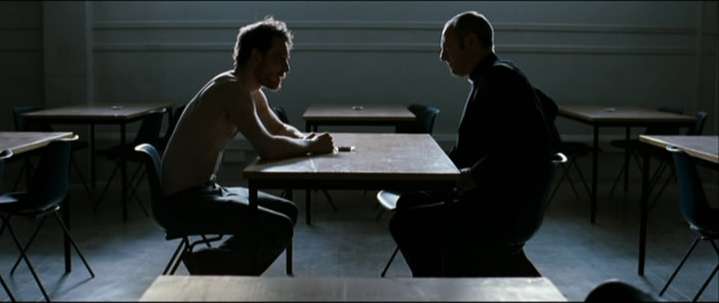Warning: Spoiler for one particular scene
Steve McQueen's debut film, Hunger chronicles the 1981 hunger strike of IRA member Bobby Sands in Northern Ireland's Maze prison. Sands wanted he and his fellow IRA inmates to be recognized as political prisoners by the British Government. Michael Fassbender plays Sands, who doesn't appear until 26 minutes in to the film. A more conventional film would've started with Sands. Hunger begins with Raymond Lohan (Steve Graham) as he goes about his day as a prison guard. We see him check his car for bombs, wash his bloodied knuckles, smoke and eat lunch. The film then introduces Davey Gillen (Brian Milligan), a new IRA prisoner, and his cellmate Gerry Campbell (Liam McMahon). Campbell has smeared his cell wall with his own feces as part of the "no wash" protest. It's through these characters the film establishes its world and the feeling of being a guards and prisoners in the Maze.
Coming back to the beginning of the film, McQueen- by showing the bottom of Lohan's car- makes us think there is a bomb. When Lohan checks underneath the car we understand this is something he checks every day. This small detail already tells us something about this man's life and the political climate. McQueen is a director who's also interested in the banal details of these peoples' lives. In a wide-shot we see Lohan smoking outside in the snow. There's a feeling of peace, that this most Lohan gets during the day; it's also the most peaceful the film gets. Then there's the scene where Gillen plays with the fly in his cell. These are the kind of details some would consider boring but they are the small things that make up every day life. The film doesn't follow a traditional act structure. Rather, it is comprised of vignettes and moments. It's sometimes easy to forget we're watching a film, so vivid is its portrayal of these events. And it's the film's often slow pace which makes the sudden outbursts of violence- most notably Lohan being killed while visiting his mother in a nursing home- all the more visceral.
What struck me about Hunger is it's almost a completely visual experience. Aside from one extended dialogue sequence McQueen and Enda Walsh's screenplay only sparsely uses dialogue. McQueen is less interested in discourse about politics or terrorism than he is in creating a specific mood and sense of realism through visuals and sound design. As described by the Criterion Collection, McQueen's is experiential and abstract.
The center-piece of the film is the aforementioned conversation between Sands and Father Dominic Moran (Liam Cunningham), which is filmed in one unbroken long take. Cinematographer Sean Bobbitt- who would photograph McQueen's other two films, Shame and 12 Years a Slave- casts Sands and Moran in silhouette. The smoke from their cigarettes is bright, somewhat blueish. The scene has the look of a film noir. It's a simple set-up but it's that simplicity which gives the scene its absorbing power. We're so accustomed to dialogue scenes being cut in a particular way. There are usually close-ups that punctuate certain lines; this scene- by not cutting- invites us to pay attention to these men's words and their body language. Cunningham actually moved in with Fassbender and they rehearsed the scene during the day. When McQueen finally cuts to a close-up of Sands the close-up has more impact because we haven't already been given a dozen of them already.
Sands tells Moran he and other IRA inmates plan to go on a hunger strike. Moran doesn't agree with Sands' stance but you can tell these two men have a mutual respect for one another. What's striking about this conversation is that it's not about the IRA being right or wrong so much as its about how far Sands is willing to go to achieve better treatment for prisoners as well as proper acknowledgement as a political prisoner. We also hear snippets of Prime Minister Margaret Thatcher discussing the prisoners but the film isn't concerned with being anti or pro Thatcher either. Her voice is there to remind us of that time and her views on these prisoners.
Fassbender lost weight to play Sands during the hunger strike and it its disturbing see someone so gaunt. McQueen doesn't attempt to lionize Sands or the IRA, though Sands seeing himself as a young boy as he's dying does verge too close to sentiment. It simply shows what he endured to be heard.
McQueen began his career in art installations before making the transition to short films and eventually feature films. McQueen's three films thus far have all been about physical and emotional violence people have been subjected to or to which they subjected themselves. McQueen's goal is to make the audience experience, with all their senses, the world of his films and the pain of his characters.



No comments:
Post a Comment